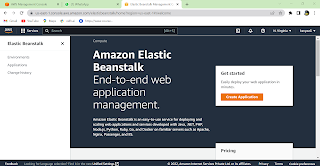Exercise the Elastic Bean stalk used for hosting web applications.

Step 1: Create account in AWS management console , and select the region. Step 2: Create an application and an Environment: -> Open the elastic Beanstalk console. -> Provide an application name and add tag and value (optional). -> Creates an Elastic Beanstalk application named newapp. Launches an environment named newapp-env with AWS resources. During the environment creation process, the console tracks progress and displays events. -> When all of the resources are launched and the EC2 instances running the application pass health checks, the environments health changes to Ok. Note: Now you can use your web application's website. Step 3: Explore Environment. -> In navigation pane, choose Environments, and then choose the name of your environment from the list. --> The environment's url is located at the top of the overview, below the environment name. Choose the url to get to the example applications congratulations page. ...





.png)